Physical Address
304 North Cardinal St.
Dorchester Center, MA 02124
A reclassification of the phylum Zygomycota into the phylum Glomeromycota has been proposed based on molecular phylogenetic studies. Acceptance of this reclassification would change the class name, Zygomycetes, to the new class of Glomerulomycetes. Instead of zygomycetes causing zygomycosis, under the proposed classification, Glomerulomycetes would cause glomerulomycosis. In that this new classification has just been proposed and is not completely accepted, this text is using the former classification within the phylum Zygomycota.
The class Zygomycetes contains a variety of hyaline, filamentous fungi that have long been recognized as important in human disease. Severe forms of infection occur worldwide in the settings of diabetic ketoacidosis or immunodeficiency producing rhinocerebral, pulmonary, or disseminated zygomycosis as well as a more indolent form of chronic subcutaneous or submucosal zygomycosis in tropical Africa and Asia. Severe immunosuppression induced in organ and stem cell transplantation patients has launched a new wave of zygomycete morbidity and mortality. The medically important zygomycetes are in two orders, the Mucorales and the Entomophthorales, with the most clinically significant and rapidly progressive diseases in immunosuppressed patients occurring from zygomycetes found in the order Mucorales. The order Entomophthorales contains two genera of medical interest, Conidiobolus and Basidiobolus, which are associated with a chronic form of zygomycosis occurring predominantly in immunocompetent individuals. The order Mucorales contains six families of significance to human disease. Most human infections are caused by members of the family Mucoraceae. Genera in this family include Rhizopus, Mucor, Rhizomucor, and Lichtheimia (formerly Absida ). Two additional pathogenic families include the Cunninghamellaceae and the Saksenaceae . Genus Rhizopus is most commonly implicated in human disease of which Rhizopus oryzae is isolated most frequently. Mucor is second in frequency followed by Cunninghamella and Lichtheimia. The term mucormycosis formerly used to refer to members of the order Mucorales has been discarded in favor of zygomycosis, which is inclusive of disease caused by members of both the Mucorales and the Entomophthorales. As a generality, the tissue morphology of the diverse zygomycetes in human disease are similar and do not allow genus or species identification for which culture is required.
Clinical disease includes rhinocerebral, pulmonary, cutaneous, gastrointestinal, and central nervous system zygomycosis. Zygomycetes produce wide (7 to 15 μm), ribbon-like hyphae in tissue with few septa and wide-angle branching ( Figure 24-1 ) as compared to hyalohyphomycetes, which tend to demonstrate narrow (3 to 6 μm) septate hyphae with acute-angle branching. For the purposes of discussion, the hyaline molds that produce narrow, septate hyphae with predominantly acute-angle branching are termed hyalohyphomycetes and include Aspergillus, Fusarium, and others. Distinguishing between zygomycetes and hyalohyphomycetes is not always straightforward, and incorrect identifications can occur when hyphae are limited in number or with artifact as in frozen section ( Figure 24-2 ). Fusarium can simulate the twisted hyphae of a zygomycete, although hyphae would be narrow. In a 10-year study of morphologic identification of fungi in histologic and cytologic specimens, errors in identification of zygomycetes versus Aspergillus constituted two of eight major errors. Failure to appropriately distinguish between a zygomycete and a hyalohyphomycete is problematic. Zygomycetes are resistant to several of the first-line antifungal agents used for Aspergillus including voriconazole. The fragile, twisted hyphae of zygomycetes are damaged during tissue collection and processing and only grow in culture in perhaps 15% of attempts. Blood cultures are rarely positive for zygomycetes. Culture from tissue may provide the only means to identify the fungus.
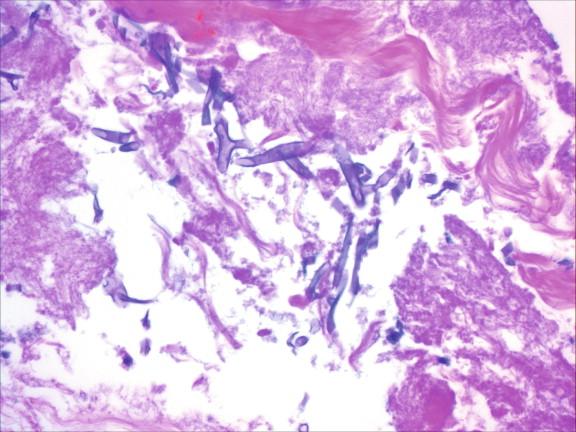
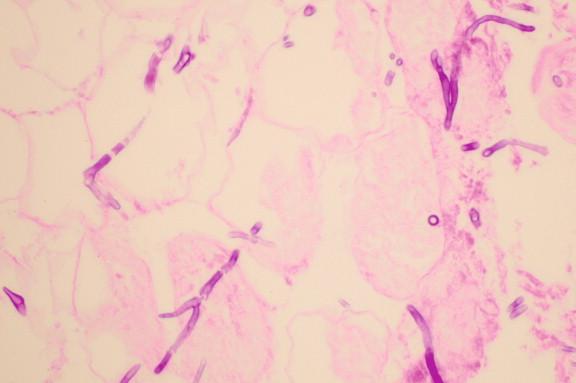
An analysis of 929 cases of zygomycosis from 1885 to 2004 found that 39% of zygomycete cases were sinus infections, 24% were lung infections, and 19% were skin infections with systemic dissemination occurring in 23% of cases. Infection can be rapidly progressive or may be chronic over years. The major predisposing factors for the development of zygomycosis are uncontrolled diabetes mellitus in metabolic acidosis, high-dose corticosteroid treatment, extensive burns, and open wounds. Treatment with the iron chelator deferoxamine for iron overload has also been associated with infection. Rhizopus species use deferoxamine as a siderophore to supply previously unavailable iron to the fungus. A substantial increase in zygomycosis has been seen in profoundly neutropenic patients with leukemia, patients with myelodysplastic syndromes, and hematopoietic stem cell as well as solid organ transplant recipients. In general, severely neutropenic patients with hematologic malignancies more commonly present with pulmonary zygomycosis. Organ transplant patients can present with either paranasal or pulmonary zygomycosis. Poorly controlled diabetes mellitus is the major underlying condition for zygomycosis of the paranasal sinuses.
Zygomycetes of the order Mucorales are widely distributed worldwide and are found in decaying vegetables, food, and fruit as well as soil and animal excreta ( Table 24-1 ). Sporangiospores produced by Mucorales are 3 to 11 μm in diameter and easily aerosolized. Airborne sporangiospores are ubiquitous and readily inhaled. Zygomycosis remains a rare disease in spite of the broad environmental presence of sporangiospores.
| Characteristic | Mucorales | Entomophthorales |
|---|---|---|
| Geographic distribution | Worldwide, most species | Worldwide but endemic in tropical areas |
| Mode of transmission | Inhalation of spores or traumatic implantation | Inhalation of spores, traumatic implantation, possible insect bites |
| Host immune status | Predominantly immunocompromised | Predominantly immunocompetent |
| Invasive qualities | Marked angioinvasion | Localized infections without angioinvasion |
| Tissue morphology | Broad, sparsely septate hyphae; Splendore-Hoeppli phenomenon is unusual | Broad, sparsely septate hyphae; Splendore-Hoeppli phenomenon is common |
Rhinocerebral and craniofacial zygomycosis are applied to zygomycete infections that originate in the paranasal sinus, upper turbinates, or less commonly in the palate or pharynx that extend into contiguous structures of the orbit, face, nose, or brain. Acute rhinocerebral zygomycosis is the most common form of zygomycete infection. Approximately 70% occur in patients with diabetes in ketoacidosis. The infection occurs worldwide. Death can occur within 7 days in an acidotic patient. Metabolic, acidosis whether due to uncontrolled diabetes, uremia, or excessive aspirin intake, predisposes to infection, although infection can occur in severely immunocompromised patients without acidosis. Rhizopus oryzae is the main pathogen.
Rhinocerebral zygomycosis commonly presents with purulent or serosanguineous nasal discharge, often unilaterally, that suggests acute bacterial sinusitis. Fever and headache are often present. The infection tends to spread to structures on the same side as nasal involvement. The hard palate may be involved, producing erythema followed by necrosis in a pattern that does not cross the midline. On the same side as the nasal involvement, skin about the nose may become edematous and painful and ultimately ulcerate. Spread of the infection to the eye produces orbital pain, diplopia, ophthalmoplegia, proptosis of the eye, edema of the lid, conjunctivitis, and corneal ulceration ( Figure 24-3 ). Funduscopic evaluation of an involved eye may show varied findings from normal to dilatation of retinal veins and thrombosis of retinal arteries. Hyphae may be visualized in the vitreous fluid. Diplopia usually results from limited extraocular muscle function or from involvement of the third nerve producing cranial nerve palsy. Progression of the infection may produce blindness, numbing of the infraorbital skin following damage to the infraorbital branch of the fifth cranial nerve, necrosis of skin inferior and medial to the orbit, and invasion of the globe. Extension superiorly from the ethmoid sinus crosses the dura into the frontal lobe of the brain producing lethargy, seizures, and coma.
Acute, rapidly progressive zygomycete infection of the upper turbinates, paranasal sinus, or uncommonly in the palate or pharynx.
Rhizopus oryzae is the main pathogen.
Zygomycetes of the order Mucorales are found widely worldwide in soil and animal excreta as well as decaying food products including fruit and vegetables.
Rhinocerebral zygomycosis commonly presents with purulent or serosanguineous nasal discharge, often unilaterally.
Fever and headache are often present.
The infection tends to spread to structures on the same side as nasal involvement, producing erythema, necrosis of the hard palate, edema, and ultimately ulceration of skin about the nose.
Spread of the infection to the eye produces orbital pain, ophthalmoplegia, proptosis, and finally loss of vision.
Extension superiorly from the ethmoid sinus crosses the dura into the frontal lobe of the brain producing lethargy, seizures, and coma.
Early sinus x-rays may demonstrate involvement of the maxillary and ethmoid sinuses, producing a cloudy appearance with a possible air/fluid level.
CT and MRI scans may demonstrate abnormal sinuses as well as signs of infarction, thrombotic occlusion, or mass lesions.
Narrowing and possible thrombosis of the intracavernous portion of the internal carotid artery often occur with thrombosis extending as far as the carotid bifurcation.
Cerebral infarction can result from embolization.
The best prognosis is in those patients without extension of disease into the brain or the internal carotid artery and in those patients in whom complete sinus drainage and debridement of infected tissue can be accomplished.
Amphotericin B in lipid formation may be useful when administered in high doses for extended periods until infection is resolved.
Combined antifungal treatment with surgical debridement may result in mortality as low as 15%.
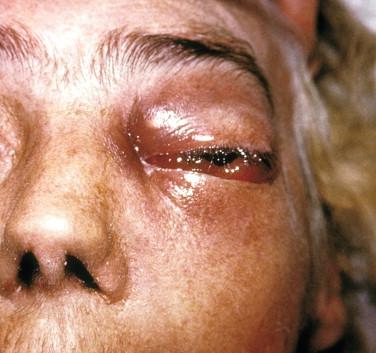
Early in the course of infection, sinus x-rays may demonstrate involvement of the maxillary and ethmoid sinuses producing a cloudy appearance with a possible air/fluid level. Computed tomographic (CT) and magnetic resonance imaging (MRI) scans may demonstrate abnormal sinuses as well as signs of infarction, thrombotic occlusion, or mass lesions. Bone destruction is seen late in the infection after soft necrosis has already occurred. Narrowing and possible thrombosis of the intracavernous portion of the internal carotid artery often occur, with thrombosis extending as far as the carotid bifurcation. Cerebral infarction can result from embolization.
Involved tissue is firm and hemorrhagic, black, or pale. Larger blood vessels may be thrombosed. Spread across tissue planes from sinus to palate or orbit to brain may be noted.
Wide, irregularly branched hyphae are present within nerve and particularly in the perineurium ( Figures 24-4 and 24-5 ) and surrounding tissue accompanied with edema and necrosis. Perineural invasion is a possible mechanism through which fungi reach the meninges, orbit, and brain in the progression of rhinocerebral disease, in addition to vascular invasion and embolization or direct extension through the cribriform plate. There may be areas of soft tissue and fat necrosis containing hyphae ( Figure 24-6 ). Zygomycetes have an affinity to grow in the internal elastic lamina of arteries, stripping the lamina away from the media, producing endothelial damage and leading to thrombosis and infarction. A neutrophilic exudate may be present except in neutropenic patients. Eosinophilic material wrapped sleevelike about hyphae (Splendore-Hoeppli phenomenon) usually is not seen as in Conidiobolus or Basidiobolus infections.
Involved tissue is firm and hemorrhagic, black, or pale.
Larger blood vessels may thrombose.
Wide, irregularly branched hyphae are present within blood vessels and surrounding tissue accompanied with edema and necrosis.
Marked perineural and neural invasion may be seen.
A neutrophilic exudate may be present but is often diminished in neutropenic patients.
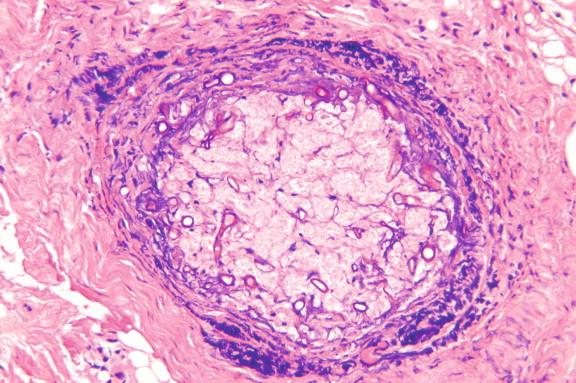
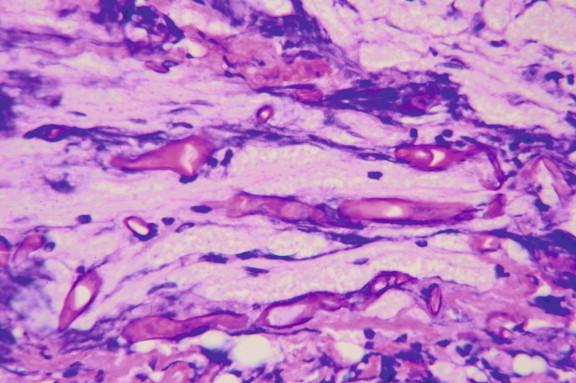
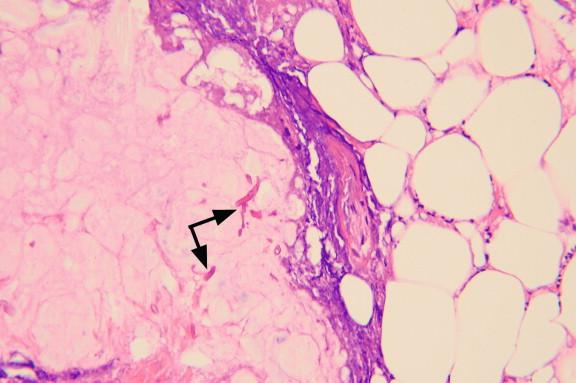
Direct examination of the bloody or purulent nasal discharge at presentation usually will reveal broad, twisted, irregularly branching hyphae characteristic of zygomycetes. Nasal discharge should be obtained through sinus aspiration or from scrapings of the upper turbinates and should be cleared in potassium hydroxide (KOH) for slide presentation. Biopsied necrotic tissue can also be mounted on a slide with several drops of KOH with gentle heating to assist the clearing process. Potassium hydroxide preparations examined by light microscopy or through Calcofluor White (Polysciences, Inc., Warrington, Pennsylvania) immunofluorescence will reveal broad, sparsely septate, thin-walled hyphae. When submitting material for culture, avoid grinding of tissue during preparation of media inoculate, which may destroy the fragile zygomycete hyphae. Careful mincing of tissue is preferable. Depending on the specimen, negative cultures occur frequently in the face of positive histology, and repeated cultures may be necessary. Inoculating media followed by placing a piece of sterile bread on the media surface may increase isolation of zygomycetes.
Zygomycetes rarely grow from cultures of blood, urine, or cerebrospinal fluid. Waiting for culture results is dangerous given the possibility of rapid progression of rhinocerebral zygomycosis. Care must also be exercised in the interpretation of positive cultures in that zygomycetes are common airborne laboratory contaminants.
There is no serologic procedure of proven reliability for the diagnosis of zygomycetes. An enzyme-linked immunosorbent assay cross-reacts with Aspergillus and Candida . β-1-3-Glycan measurement in serum is useful to assist in the diagnosis of a variety of fungal diseases including those caused by Aspergillus, Candida, and Pneumocystis but not for disease caused by zygomycetes. Neither galactomannan nor β-1-3-Glycan is useful to diagnose or follow zygomycete infections.
Available methods for susceptibility testing are the M38-A reference method for filamentous fungi and the E test (AB Biodisk, Solna, Sweden), but it is often difficult with these fungi to reach accurate, consistent end points. As the interpretive minimal inhibitory concentration (MIC) breakpoints are undefined for zygomycetes and the correlations between clinical response and MIC values for a given strain are uncertain, the use of antifungal susceptibility testing in zygomycosis for routine clinical decisions is of uncertain value. Zygomycetes appear to be susceptible to amphotericin B, although as much as a third of Cunninghamella sp. may be resistant. Zygomycetes are generally not susceptible to most of the triazoles and echinocandins and are considered resistant to voriconazole, a first-line agent useful for treating a wide variety of fungal infections including most species of Aspergillus . Posaconazole appears to possess activity against most zygomycetes.
Early in the course of disease, both the clinical and radiologic features of bacterial and fungal sinusitis may be similar. Orbital extension can be mistaken for cavernous sinus thrombosis. Proptosis and periorbital edema may be seen with both diseases, but progression to necrosis of the turbinates, palate, and skin of face is only seen in rhinocerebral zygomycosis. Limited numbers of hyphae or tissue preparation artifact may make the distinction between zygomycetes and other narrow hyalohyphomycetes such as Aspergillus difficult. In such instances, one should formulate a surgical pathology diagnosis that is inclusive of all mycelial fungi in the differential diagnosis in order to allow the treating physician to select the most appropriate antifungal regimen.
The best prognosis is in those patients without extension of disease into brain or the internal carotid artery. A CT or MRI scan may help to determine the extent of involved tissue to guide surgical debridement. Extensive debridement and drainage of sinuses may need to be repeated daily for a period of time. Prognosis may be poor for those cases in which infected tissue is inaccessible to surgical debridement. Amphotericin B in lipid formation may be useful when administered in high doses for extended periods until infection is resolved. Itraconazole has low activity against the zygomycetes, and voriconazole is considered to possess little or no activity. Posaconazole may be useful. Appropriate, rapid treatment combining antifungal treatment with surgical debridement may result in survival of as many as 85% of patients with acute rhinocerebral zygomycosis.
Pulmonary zygomycosis is a form of zygomycosis seen in patients with predisposing factors of diabetes, steroid use, and surgery. However zygomycosis of the lungs is very rare outside of neutropenic, posttransplantation patients or those with hematologic malignancies. In a European study of multiple transplant centers from 2005 through 2008, 58 solid-organ transplant patients developed zygomycosis, with an incidence of 3.2 infections per 1000 transplants. Of these, 31 (53%) developed pulmonary zygomycosis. Of the 31 patients with pulmonary zygomycosis, about three quarters had disease restricted to the lungs with the remaining developing disseminated zygomycosis.
Most patients present with fever of unknown origin frequently with cough, dyspnea, and chest pain unresponsive to broad-spectrum antibiotics. Fever may be absent particularly in patients treated with corticosteroids. Some patients have hemoptysis, possibly massive, that may arise following erosion of a major blood vessel. Pulmonary zygomycosis may be a fulminant disease leading to rapid demise. Over 75% of patients with hematologic malignancies or following human stem cell transplantation presenting with pulmonary zygomycosis also possess concurrent sinus involvement.
Radiologic findings are varied, reflecting the wide range of pulmonary disease from isolated solitary lesions, lobar consolidation, to cavitary lesions ( Figure 24-7 ). Initially, a rapidly progressive bronchopneumonia, segmental or lobar consolidation, may be seen in one or more areas of the lung. If the patient survives long enough, cavitation with an air-crescent sign may be detected, suggesting Aspergillus ( Figure 24-8 ). Pleural effusion is variably present. Characteristically wedge-shaped pulmonary infarcts can be produced by thrombosis of pulmonary vessels.
Pulmonary zygomycosis may be seen as the primary disease or as a component of disseminated zygomycosis.
Zygomycosis of the lungs is very rare outside of populations of neutropenic patients posttransplantation or of those with hematologic malignancies.
Rhizopus species were isolated most frequently, followed by Lichtheimia and Mucor.
Sporangiospores of zygomycetes are widely distributed in the environment and are readily inhaled.
Most patients present with fever of unknown origin frequently with cough, dyspnea, and chest pain.
Some patients have hemoptysis.
Concurrent sinus involvement is frequent.
Radiologic findings may show a rapidly progressive bronchopneumonia, segmental or lobar consolidation, in one or more areas of the lung.
Cavitation with an air-crescent sign may be detected.
Mortality is widely variable depending on local pulmonary or disseminated disease. In solid organ transplant patients, mortality can approach 75% in those with disseminated zygomycosis in conjunction with lung infection.
A combination of amphotericin B treatment with surgery produces better patient outcome.
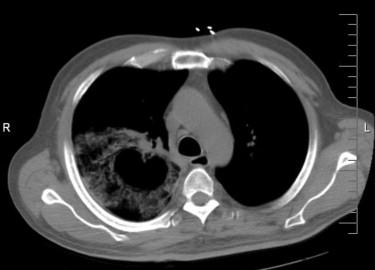
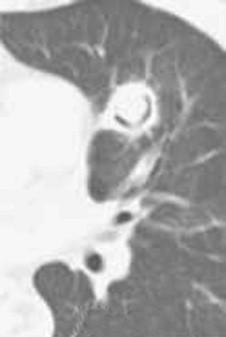
Invasion of contiguous structures including diaphragm, heart, and mediastinum may be seen. Lung tissue may be firm or hemorrhagic. Thrombosis is often seen in larger vessels.
Damage to pulmonary parenchyma includes coagulative necrosis, infarction, and often pulmonary hemorrhage ( Figure 24-9 ). A neutrophilic inflammatory infiltrate is usually present but may be less prominent in neutropenic patients. In spite of the usual rapid course of this disease, granulomatous inflammation is sometimes seen. Abundant broad (7 to 15 μm) hyphae lack regular septations ( Figure 24-10 ). Hematoxylin and eosin and periodic acid-Schiff (PAS) staining usually stain zygomycete hyphae well, but Gomori methenamine silver (GMS) staining is variable and frequently completely negative ( Figure 24-11 ). Angioinvasion may be prominent ( Figure 24-12 ) producing intravascular thrombosis ( Figure 24-13 ). The hyphal walls are thin but variable, which contrasts with the uniform wall thickness of Aspergillus . The lack of structural integrity produced by the thin wall allows collapsing, twisting, and folding of zygomycete hyphae in tissue preparations. This instability probably also diminishes fungal viability during handling of specimen for culture. Branching of zygomycetes is variable and often 90 degrees, which differs from the often uniform, dichotomous (45-degree) branching of Aspergillus.
Pulmonary parenchyma contains areas of coagulative necrosis, infarction, and often pulmonary hemorrhage.
Neutrophilic inflammatory infiltrate is usually present.
Angioinvasion is usually marked, producing intravascular thrombosis.
Abundant broad (7 to 15 μm) hyphae lack regular septations and demonstrate irregular, often 90-degree branching.
Staining is good with H&E and PAS; variable to no staining may be seen with GMS.
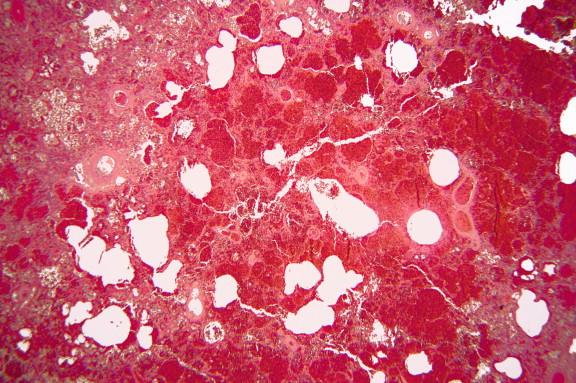
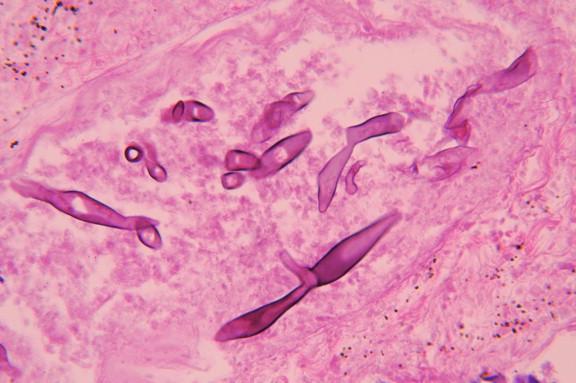
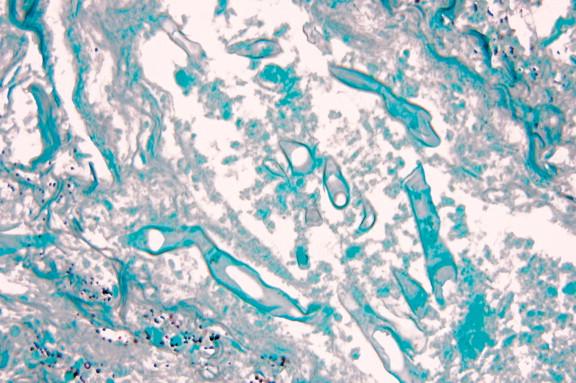
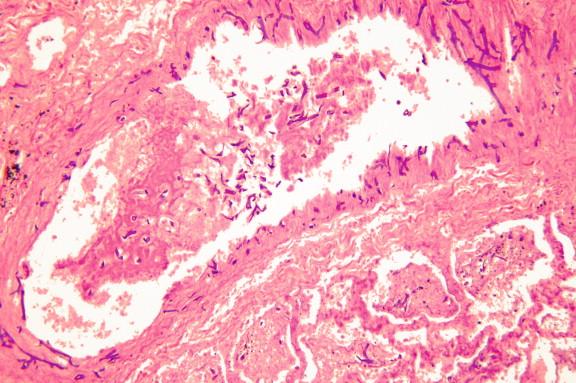
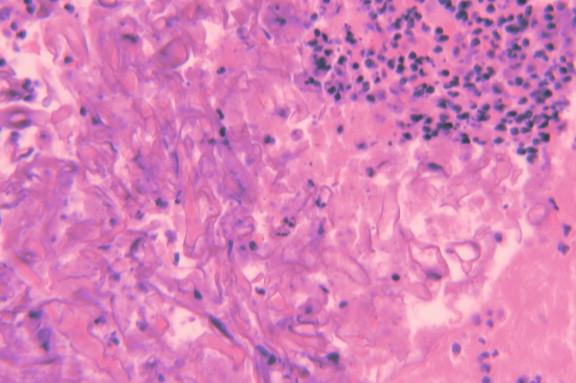
A CT scan can define the extent of pulmonary involvement to guide needle aspirations. Bronchoalveolar lavage, transbronchial biopsy, or open lung biopsy may be necessary. Serologic studies may lack specificity. Routine laboratory testing may be of little value to establish the diagnosis. Cultures of blood are frequently negative. In multicenter studies of solid organ transplant patients, Rhizopus species were isolated most frequently, followed by Lichtheimia (formerly Absidia ) and Mucor . Lichtheimia may have a higher risk of systemic dissemination.
Molecular techniques are not routinely available for zygomycetes identification from tissue specimens.
Pulmonary zygomycosis is clinically indistinguishable from pulmonary aspergillosis and pseudallescheriasis. Features of angioinvasion may be identical. Zygomycete hyphae of the Mucorales are characteristic enough that experienced pathologists can make a dependable diagnosis of zygomycosis in most cases if provided with properly prepared and stained histologic sections, although caution is necessary when hyphae are limited in number or tissue artifact is severe.
Mortality is widely variable depending on predisposing disease and whether or not infection is limited to the lungs or is disseminated. One large study of solid organ transplant (SOT) patients demonstrated a mortality of 34% in localized pulmonary zygomycosis, increasing to 75% in disseminated pulmonary disease. Disease localized to the lungs is more likely to be amenable to surgical resection leading to a lower mortality. In one study of solid organ transplant patients with pulmonary zygomycosis treated with amphotericin B alone compared to patients treated with surgery and amphotericin B, mortality diminished from 50% to 6.6% in the combined group.
Disruption of the skin surface either by trauma, surgery, or burns can predispose a patient to cutaneous zygomycosis. Overall, cutaneous zygomycosis is seen in approximately 19% of all zygomycete infections in all age groups, but in children, skin represents the most frequent site of infection by zygomycetes. Skin is a common site of disseminated disease encountered in systemic zygomycosis in solid organ transplantation patients with pulmonary zygomycosis. A significant proportion of patients with cutaneous zygomycosis have otherwise normal immunity. In a large series of cutaneous zygomycosis, 40% had no underlying immune impairment, 23% has hematologic malignancy, 13% has diabetes mellitus, 6% had solid organ transplant, 5% received corticosteroids, and 13% had other varied diseases. Cutaneous zygomycosis can be very invasive locally with extension into adjacent fat, muscle, fascia, and bone. Infection can disseminate systemically, particularly in a predisposed host. Cutaneous zygomycosis can result from minor trauma encountered in motor vehicle accidents or crush injuries. Cutaneous zygomycosis was a major cause of infection following the tsunami that struck Southeast Asia in 2004 and, more recently, as a cause of cutaneous infection in survivors injured by flying debris in the Joplin, Missouri, EF 5 tornado. Cutaneous zygomycosis has emerged as an important hospital-based infection. Nosocomial cutaneous zygomycosis has been associated with immunosuppressed patients and a variety of medical devices including bandages, medication patches, and intravenous or arterial catheters. Cutaneous and wound zygomycosis can be seen with all zygomycetes and Rhizopus appears to cause the majority of skin infections, but Apophysomyces elegans, Saksenaea vasiformis, Cunninghamella bertholletiae, Rhizomucor, and Mucor species have been identified.
Patients with cutaneous zygomycosis can be divided into three groups: those with infection confined to the skin or subcutaneous tissue, those with infection extending deeper into underlying tissue, and those with disseminated disease. Any area of the body can be infected by zygomycetes. In general, the extremities are more commonly involved. Likewise, the course of the disease varies from gradual to rapidly progressive. Skin lesions are usually single. The infection may have varied manifestations including induration, blisters, pustules, or necrotic ulcerations. A targetoid appearance has been described with an erythematous induration surrounding a necrotic central area.
Become a Clinical Tree membership for Full access and enjoy Unlimited articles
If you are a member. Log in here